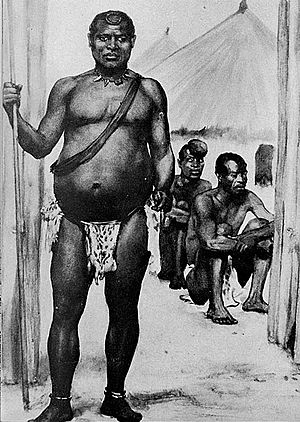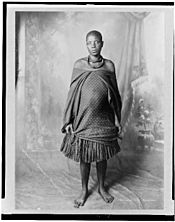Lobengula facts for kids
Quick facts for kids Lobengula Khumalo |
|
|---|---|
| King of Matabeleland (also encompassing Mashonaland) |
|
 |
|
| Reign | September 1868 – January 1894 |
| Coronation | 1869 |
| Predecessor | Mzilikazi (Father) |
| Successor | Bulelani Lobengula |
| Born | ca. 1845 Matabeleland |
| Died | presumed January 1894 ca. 70 km south of the Zambezi river in Matabeleland |
| Spouse | Lozikeyi (1st royal wife), Lomalongwe (2nd royal wife) |
| Issue | Mpezeni (royal son and heir) born in Bulawayo ca. 1880 and died at Somerset Hospital on 9 December 1899 of pleurisy, Njube (royal son), Nguboyenja (royal son) sent to Cape Town after death of Lobengula and buried at Entumbane near to Mzilikazi, Sidojiwa born at Nsindeni ca. 1888 (royal son) and died 13 July 1960 (buried at Entumbane near to Mzilikazi), and at least one daughter |
| House | Khumalo |
| Father | Mzilikazi Khumalo, first king of the Northern Ndebele people |
| Mother | Princess of the Swazi House of Sobhuza I., an "inferior" wife of Mzilikazi |
Lobengula Khumalo (born around 1845, died 1894) was the second king of the Northern Ndebele people. These people were historically known as the Matabele in English. The name "Ndebele" means "the men of the long shields." This refers to their brave warriors who used large shields and spears, much like the Zulu people.
Contents
The Ndebele People: A Brief History
The Ndebele people were originally part of the Zulu people. They moved north during a time of great change and conflict in Southern Africa. This period was called the mfecane, meaning "the crushing" or "the scattering."
Moving to Matabeleland
A Zulu general named Mzilikazi led his followers away from Zulu territory. In the late 1830s, they settled in an area now known as Matabeleland. This region is in western Zimbabwe. The Ndebele claimed control over a much larger area than just Matabeleland.
Life in the Ndebele Kingdom
People who were part of the Ndebele tribe had special rights. However, everyone, men and women, followed strict rules. These rules set out their duties to society. Breaking these rules could lead to severe punishments. This strong discipline and loyalty helped the Ndebele army become very powerful. They were able to control their neighbors because of their strength and organization.
Becoming King: Lobengula's Story
After King Mzilikazi died in 1868, the Ndebele chiefs, called izinduna, needed a new leader. They chose Lobengula, one of Mzilikazi's sons.
A Challenge for the Crown
Some groups of warriors, called impis, did not agree with Lobengula becoming king. The disagreement was settled through a battle. Lobengula and his warriors bravely defeated the rebels. His courage in this fight led to everyone agreeing that he should be king.
The King's Crowning Ceremony
Lobengula's coronation, or crowning ceremony, took place at Mhlahlandlela. This was one of the Ndebele's main military towns.
A Grand Gathering
The Ndebele nation gathered in a large semicircle. They performed a powerful war dance. This showed their loyalty and willingness to fight for Lobengula. Many cattle were sacrificed, and the best meats were offered to Mlimo, the Ndebele spiritual leader, and to the late King Mzilikazi. People also drank a lot of millet beer.
Warriors in Full Dress
About 10,000 Ndebele warriors attended the crowning. They wore special war costumes. These included a headdress and a short cape made of black ostrich feathers. They also wore a kilt made of leopard or other animal skins, decorated with white cattle tails. Around their arms and ankles, they wore similar tails and metal rings.
Weapons of the Ndebele
Their weapons included long spears for throwing and a short stabbing-spear called an assegai. The assegai was also the main weapon of the Zulu people. For protection, they carried large oval shields made of ox-hide. The color of the shield (black, white, red, or speckled) showed which impi (regiment) the warrior belonged to.
The Strength of the Army
The Ndebele kept their power because of their large and well-trained army. Every able-bodied man in the tribe served in the army. The Ndebele army had about 15,000 men organized into 40 regiments. These regiments were based around Lobengula's capital city, Bulawayo.

Lobengula's Rule and Agreements
In 1870, Lobengula allowed Sir John Swinburne's London and Limpopo Mining Company to search for gold. This was in a small area of Matabeleland near the Tati River. However, serious mining in this area did not start until around 1890.
Dealing with White Hunters
Lobengula was generally welcoming to white hunters who came to Matabeleland. He even punished his own people if they threatened the white visitors.
The Rudd Concession
In 1888, a British team came to ask Lobengula for permission to dig for minerals in more parts of his land. Lobengula was careful about making such a deal. He only agreed when his friend, Leander Starr Jameson, helped. Jameson was a doctor who had treated Lobengula for gout. He promised money and weapons for the Ndebele. He also promised that anyone who came to dig would be considered to be living under Lobengula's rule.
As part of this agreement, called the Rudd Concession, the British insisted that the Boers (Dutch settlers) and Portuguese would not be allowed to settle or gain land in Matabeleland. Lobengula sent two messengers to Queen Victoria in Britain. However, they were delayed at the port. Lobengula signed the 25-year Rudd Concession on October 30, 1888.
The Matabele War
The First Matabele War began in October 1893. The British South Africa Company had a much stronger army. This led to huge losses for the Ndebele warriors, especially at the Battle of the Shangani.
The End of Lobengula's Reign
By December 1893, it was reported that Lobengula was very sick. His death, which happened in early 1894, was kept a secret for many months. The exact cause of his death is still not fully known. By October 1897, white colonists had settled in much of the territory. This land later became known as Rhodesia. Matabeleland, as an independent kingdom, no longer existed.
Personal Life
Lobengula had many wives, possibly more than 20. Among them were Xwalile, who was the daughter of King Mzila of the Gaza Empire, and Lozikeyi.
See also
 In Spanish: Lobengula para niños
In Spanish: Lobengula para niños


